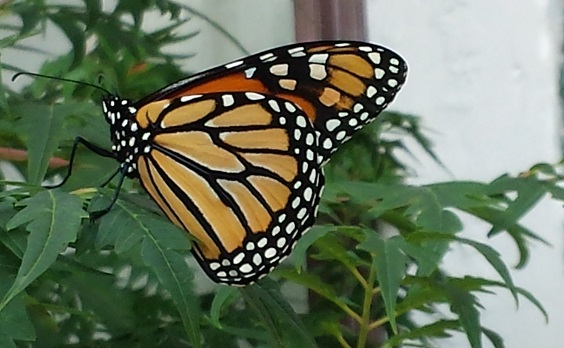February 4, 2018 – Saving the Monarch, Round 2: Pessimists v. Optimists
![]() One of my favorite writers of all time once coined the phrase, “You can catch more flies with honey than with battery acid.” Unfortunately, that’s a philosophy that I’ve never particularly taken to heart, especially on my radio show. Perhaps that’s because, when it comes to environmental matters, I take more pleasure in whupping people upside the head with rolled up newspapers than I do trying to sweet talk them into understanding the grave danger we face in the 21st Century.
One of my favorite writers of all time once coined the phrase, “You can catch more flies with honey than with battery acid.” Unfortunately, that’s a philosophy that I’ve never particularly taken to heart, especially on my radio show. Perhaps that’s because, when it comes to environmental matters, I take more pleasure in whupping people upside the head with rolled up newspapers than I do trying to sweet talk them into understanding the grave danger we face in the 21st Century.
Take the monarch butterfly (Danaus plexippus), for instance–more specifically, the eastern monarch population. This is the group of monarchs that migrate every year from their winter home in the mountains of Mexico into the United States and Canada, where they can be found as far north as the province of Alberta and as far east as Newfoundland.
 As we’ve now been discussing on The Mike Nowak Show for what seems like decades, monarchs seem to be in trouble. Since the 1990s, their numbers have dropped an alarming 80%. The February 2017 graph on the left from Journey North shows how precipitous the decline has been.
As we’ve now been discussing on The Mike Nowak Show for what seems like decades, monarchs seem to be in trouble. Since the 1990s, their numbers have dropped an alarming 80%. The February 2017 graph on the left from Journey North shows how precipitous the decline has been.
Let’s put it this way. If this were a chart of a your financial portfolio, you would have a few questions for your advisor…before escorting that person to the door.
It has now become a ritual each February to hold our collective breaths and wait for the official count of overwintering monarchs. As you can see from the chart, with the exception of 2016, there hasn’t been a lot of good news lately. So we probably didn’t need the weather anomaly that we experienced towards the end of 2017.
“It was the warmest fall we’ve ever had, at least in the last 123 years,” [Chip] Taylor said. Average high temperatures in the Northeast exceeded 60 degrees in September and October for the first time, according to the National Oceanic and Atmospheric Administration.
While the warm temperatures gave humans a few more days to hang out at the beach, the same thing happened with some monarch butterflies, which might have been confused by the unusual warmth and began their trek south dangerously late.
This delayed migration is not normal, and it alarmed monarch researchers across the country. The Cape May stragglers were only a sliver of the record number of monarchs reported in the Northeast in November and December — news that sounded good initially to conservationists. But seeing butterflies so far north so late in the year suggested that few of these latecomers would reach their Mexican wintering grounds. Scientists fear that climate change is behind what they’re calling the latest monarch migration ever recorded in the eastern United States, and they worry that rising temperatures pose a new threat to a species that saw its population hit record lows in recent years.
Some optimistic observers wonder if the warm weather produced a “bonus” generation of monarchs, which might be a good thing. Uhhh…we’ll get to that in a second.
And that’s just the eastern monarch population. There is another group of monarchs in North America, called western population. These are the monarchs that live west of the Rockies and migrate to California for the winter. We just received the numbers for 2018…and the news is not good.
An annual census of monarch butterflies overwintering along California’s coast reveals that populations in western North America are at their lowest point in five years, despite recovery efforts. Volunteers with the Xerces Society’s Western Monarch Thanksgiving Count visited more sites this past year than have ever been counted since the survey began in 1997, yet they tallied fewer than 200,000 monarchs.
Just last year, the count was 300,000. Two decades ago, it was 1.2 million.
Which brings us to author Kylee Baumlee, who was on our program just last year to promote her (then) new book, The Monarch: Saving Our Most-Loved Butterfly, which is now in its second printing. She’s one of those crazy optimists who think that since humans probably have had a lot to do with the decline of this iconic species, we can also fix the problem. That’s why she devotes whole chapters to how concerned folks can take action to help the monarch.
And in this corner, we have Mike Nowak, noted curmudgeon and pessimist, who notes that the planet it in the midst of the Sixth Great Extinction and thinks that the disappearance of the monarch butterfly might just be the act that causes us to sit up and take notice. Or not.
So I guess we’ll just duke it out this morning. Baumlee is in town for the 2018 Midwest Perennial Plant Association Symposium: Plants for Pollinators at the Morton Arboretum. If she had been smart and ducked out of town after her Saturday presentation, she would probably be safely home right now. But, noooo–she decided to stick around to come to the WCGO studios and will have to make her way back to Ohio through the snow. It’s kind of flattering, actually.
 She’s joined in the studio this morning by a couple of friends of The Mike Nowak Show who were also on the program last year—Carol Niec and Kerrie Rosenthal, who are the brains and brawn behind The Seed Keeper Company. Their collective goal is to make gardening easier by developing a seed filing system for seed packets and captured seeds. They also provide tips and planting accessories.
She’s joined in the studio this morning by a couple of friends of The Mike Nowak Show who were also on the program last year—Carol Niec and Kerrie Rosenthal, who are the brains and brawn behind The Seed Keeper Company. Their collective goal is to make gardening easier by developing a seed filing system for seed packets and captured seeds. They also provide tips and planting accessories.
Not only that, but for eight years they have been sponsoring the The Seed Keeper Project, which to date has recognized more than 350 school gardens in all 50 states and the District of Columbia. Here’s how it works:
- Now and for the next four weeks, they post 10 States each week for 5 weeks in alphabetical order on their Facebook page.
- During the week you can nominate a K-12 school (public, private or homeschool) and post it on their FB Page.
- Should there be a tie for nominated school gardens within a state, the winner will be drawn using random.org at the end of that week.
- The name of the nominating person is mentioned in the winning certificate.
Each winning school receives Seeds of the Month Club (52 packs of seeds) and the essential gardening companion book– Garden-pedia by Maria Zampini and Pamela Bennett! Other sponsors include Corona Tools and GrowScripts, which will provides slow-release fertilizer to each winning school garden.
Kylee, Carol and Kerrie will be joining us in the studio for the whole show this morning, so who knows where the conversation will go? It will certainly cover seed starting and the fate of the monarch butterfly–but rumor has it that a few special guests could be calling in. And will Carol and Kerrie be wearing their famous gardening boots? If the snow is still coming down, that’s a distinct possibility.

